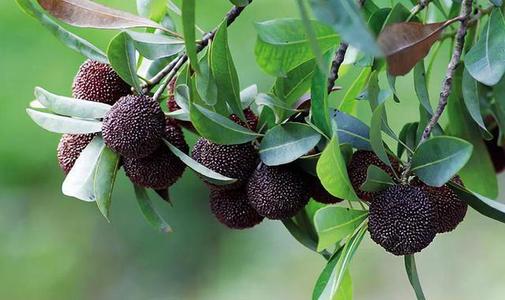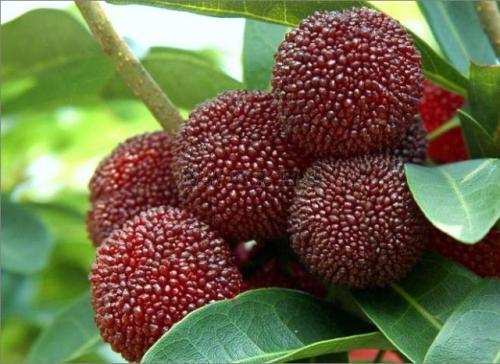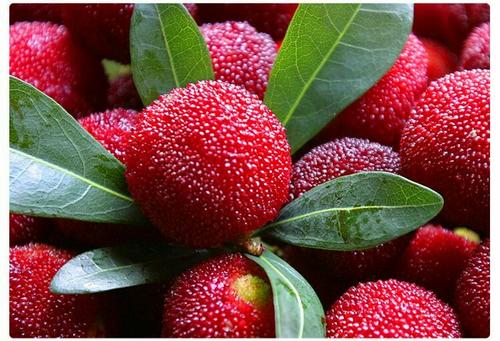How to Grow and Care for Chinese Bayberry Tree
Written by Maggie
Dec 06 2021

Chinese Bayberry is famous specialty fruit in China. Chinese Bayberry, tree leaves, tree roots and bark all have medicinal value. The Chinese Bayberry tree is an evergreen tree with a height of more than 15 meters. The Chinese Bayberry is round in shape, it starts out light red, then turns dark red. Chinese Bayberry tastes good, sweet and sour. Chinese Bayberry is suitable for growing in slightly acidic soil, can withstand shade, like wet environment, but not cold. Chinese Bayberry is not only better in taste, but also nutritious and effective.
What environment is suitable for Chinese Bayberry to grow in? What requirements do Chinese bayberries have for temperature, watering, light and soil when growing? Where can I grow Chinese Bayberry? The following are Chinese Bayberry tree care and propagation guide.

Chinese Bayberry Tree Growing Stage
Sapling Stage
The sapling stage of the Chinese Bayberry Tree is 1 to 7 years.
It requires pruning in the first 1 to 5 years for the whole tree. After the chinese bayberry seedlings survive and the tree height reaches between 50-60 cm, it should begin to pick the tree heart. At 80-90 cm, the tree has five to six strong branches. Sapling is the most important stage of crown formation. On the basis of the original tree shape, select the backbone branches of each layer (to ensure that the fruit quality of the mature chinese bayberry tree later, reduce the occurrence of diseases and insect pests), which makes a favorable foundation for long-term yield.
Mature Stage
In this stage, it is mainly to observe the Chinese bayberry tree leaves whether the tree needs to be fertilized. It is better to have thick and dark green color leaves. Chinese Bayberry trees are suitable for acid soils.
Adult trees generally begin bearing fruit at more than 7 years. Finally, note that there are male and female Chinese Bayberry trees. The typical planting rate is between five and eight percent. This is the most reasonable proportion off male and female trees.
Chinses Bayberry Care Basic info
| Botanical/Scientific Name | Myrica Rubra |
| Common Names | Yangmei, Yamamomo, Chinese bayberry, Japanese bayberry, red bayberry, Yumberry, Chinese Bayberry, Chinese strawberry |
| Best Growing Time | Chinese Bayberry Tree is best to grow in spring when the temperature begins to warm on cloudy or light rain days. |
| Best Growing Soil | Chinese Bayberry Tree is suitable to grow in acidic or slightly acidic soil. The best soil is sandy loam with loose soil, good drainage, gravel and PH between 4.5 and 6.5. |
| Best Growing Humidity | Chinese Bayberry tree likes high humidity and is shade tolerance. Generally, if have adequate rain and in high humidity, the Chinese Bayberry tree grows lush and will bear fruit early with high yield and good quality. |
| Best growing Temperature | Chinese Bayberry likes a warm climate. Its temperature requirements are similar to loquat and citrus trees. The most appropriate annual average temperature is 15-20 ℃, and the absolute minimum temperature is not less than -5℃ for seedlings and -12℃ for cultivated trees. |
| Best Growing Light | Chinese bayberry trees have no strict requirements for sunshine. |
Where to Grow Chinese Bayberry Tree
Different plant locations have an impact on the growth of Chinese Bayberry Tree.- When planting Chinese Bayberry on sloping land, due to the low terrain, the water content in the soil is sufficient, and the sweet taste of Chinese Bayberry fruit planted is relatively light.
- Planting Chinese Bayberry in the mountains, where has rich soil and have direct light exposure, the fruit will be relatively large and good quality.
- The soil fertility of Chinese Bayberry planted on the steep hillside is relatively thin, the fruit is relatively sweet but the yield is not very ideal.
Chinese Barberry Temperature Care
Chinese Bayberry is an evergreen fruit tree, which likes warm climate, and is cold and drought-resistant with strong adaptability. The annual average temperature is required at 15~20℃, and the minimum temperature is not lower than -9℃. Generally, when we grow and care for Chinese Bayberry, the average temperature in winter is 3℃, and the average temperature in summer is not less than 29℃. The appropriate temperature for flower bud differentiation is 20~25 °C. The high temperature drying is not good for the growth of Chinese Bayberry, especially the hot sun irradiation, which is easy to cause the withered and scorched branches and death.
Chinese Bayberry flowering temperature is 5℃ above, good fruit. When we grow and care for Chinese bayberries, when the temperature drops to 2℃ below, affect the flowering fertilization. Below 0℃, the flower apparatus suffers from cold, and the flower falls seriously. When the temperature of young fruit is higher than 35℃, a large number of fruit drops will be formed, or the sugar content of the fruit will decrease, the acid content will increase, and the quality will decline.
Chinese Bayberry Watering
Chinese Bayberry is good moisture and shade resistance, and requires sufficient moisture. The annual rainfall is more than 1300 mm. Especially in spring to autumn to require more moisture. Spring shoot growth and fruit development period from spring to summer, if the water is abundant, the new shoot growth is vigorous, the fruit is hypertrophic, the top of the fleshy column is round and blunt, the flesh is soft and juicy. Conversely, it can make new shoots grow slowly, fruit-shaped decrescent, fleshy column shape is pointed, juice little taste bad. When we grow and care for Chinese Bayberry in spring to autumn, water supply is adequate, is conducive to later growth of trees, can trigger new tip, increase leaf area index, enhance photosynthesis, thus ensuring the nutrient accumulation and flower bud differentiation, to lay a good foundation for the blossom of the second year, so Chinese Bayberry distributed between the mountains deep canyons, rivers and coastal the lake area.

Chinese Bayberry Lighting
Chinese Bayberry is a shade tolerant tree species, avoiding high temperature and scorching sun. In coves or places where the sun is not so strong, the trees are strong and live long, and the fruit is juicy and sweet and brightly colored. If planted in the top of the mountain or the south slope, the tree is weak, short life, small fruit, meat column tip, less juice, poor quality. Therefore, when we grow and care for Chinese Bayberry, Chinese bayberries are suitable to be planted in shady mountain areas.
Chinese Bayberry Soil Care
When we grow and care for Chinese Bayberry, it is better to plant Chinese Bayberry in loose, well-drained sandy red soil or yellow sandy gravel soil. If the soil is fertile and the gap is large, it is conducive to the growth of roots. Chinese Bayberry likes acid soil, and it is appropriate to take pH value of 5~6. Chinese Bayberry can be planted where there are ferns, oak, azalea, myrtle, pine trees and so on, and it grows well. Chinese Bayberry trees are suitable for planting in the area below 2000 meters above sea level.
Growing tips: Chinese Bayberry belongs to the wind medium flower, like breeze, but because of the tall tree body, shallow root system, it is easy to be hit by typhoons.

Chinese Bayberry Fertilizer
Fertilization is the key to high yield and good quality of Chinses Bayberry. Overgrowth of Chinese Bayberry trees is the main reason for fruitlessness if the fertilization time is not properly controlled. Although Chinese Bayberry trees contain mycorrhiza, the nitrogen fixation capacity is limited. It is still necessary to supplement appropriate nitrogen fertilizer, but the application of nitrogen fertilizer should not be too much, otherwise it is easy to cause the OBER growth of branches, which is not conducive to the flowering and fruit of Chinese Bayberry. Chinese Bayberry likes potassium fertilizer very much. Potassium fertilizer can accelerate the lignification rate of Chinese Bayberry Tree and increase the sugar content of Chinese Bayberry fruit.Chinese Bayberry Pruning
The main tree shape of Chinses bayberry is a natural round head. The pruning of saplings is mainly to develop early and fruitful trees. Choose 3-4 branches with strong growth, distributing in orientation and with a certain distance (about 20-30 cm) from each other as the main branches, and choose 2-3 side branches on each main branch to make the distribution reasonable and clear, and basically form the crown skeleton in 3-5 years. The pruning of adult trees mainly regulates the relationship between growth and fruiting.Chinese Bayberry Disease & Pest Control
The resistance of the Chinese Bayberry Tree is strong, so the disease and pest problems rarely occur. However, poor ecological environment or care can lead to pests and diseases. The main insect pests of Chinese Bayberry trees are white scale, leaf curl moth and pouch moth. The main diseases of Chinese bayberry trees are brown spot disease, red clothing disease, cancer disease and so on. Prevention and control methods: strengthen care measures, enhance tree potential; Cut off diseased and dead branches in time; Remove fallen leaves and weeds timelyChinese Bayberry Propagation
The propagation methods of Chinese Bayberry Tree include seedling, cutting, layering and grafting propagation.Seedling propagation is simple and large in number, but from the germination of the seed, the plant is malleable and easy to variegated. In production practice, the plants that become good are often less, most to the bad aspect transformation. Therefore, modern Chinese Bayberry tree with seed propagation is very little. When using cutting propagation, only in the application of growth regulator, the Chinese Bayberry Tree can take root, so generally it is not used. Due to low propagation coefficient and poor root growth, layering propagation is rarely used in practice. The grafting propagation of Chinese bayberry has a history of hundreds of years. Now the general propagation is that first with seed sowing, propagate seedlings, and then use cutting and grafting multi propagation methods, by which the propagation coefficient is great.
Read More: How to Propagate Chinese Bayberry
Chinese Bayberry Profile: Tree & Fruit Info
Latest Updated
- Benefits of Bugleweed - 7 Science-backed Health Benefits
- Bugleweed Dangers & Side Effects - Is It Poisonous?
- How to Plant Evergreen Trees - What You Should Know
- When to Plant Evergreens - Grow Guide for Evergreen Trees
- 12 Wonderful Evergreen Shrubs for Your Garden
- 12 Popular Evergreen Plants with Pictures for Beginners
- When And How To Prune A Lilac Bush Like a Pro
- How to Grow & Care for Lilac Vine (Hardenbergia Violacea)
- Japanese Lilac Tree (Syringa Reticulata) Care & Propagation Guide
- Shumard Oak Pros and Cons - What to Know
Popular Articles
- Winter maintenance of Antirrhinum Majus
- How to Grow Terminalia Mantaly Tree
- How to Grow and Care for Crossostephium Chinense
- How to grow Antirrhinum Majus in spring
- Peristeria Elata (Dove Orchid) Profile: Info & Care Guide
- Underwatered Snake Plant (Sansevieria Trifasciata) - Signs And How To Fix
- How to Care for Brazilian Jasmine Plant (Mandevilla Sanderi)
- How to Grow & Care for Graptopetalum Purple Delight in Summer
- Rosa Chinensis (China Rose): Plant Growing & Care Tips
- How to Care for Baby Sun Rose (Aptenia Cordifolia)